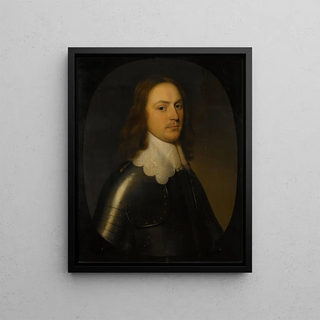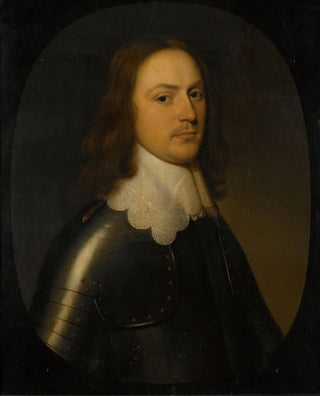Art print | Portrait of an officer - Gerard van Honthorst Source: Reproduction | Portrait d'un officier - Gerard van Honthorst


View from behind

Frame (optional)
The "Portrait of an Officer" by Gerard van Honthorst is a work that transcends the simple frame of a painting to immerse the viewer in the rich and complex universe of the 17th century. Through this portrait, the Dutch artist manages to capture not only the physical appearance of his subject but also the very essence of his character and social status. This painting, emblematic of the Baroque period, evokes the power and dignity of a man in uniform, while revealing the subtleties of an era marked by political and cultural upheavals. Honthorst's mastery of light and shadow, signature of his style, invites deep and immersive contemplation.
Style and uniqueness of the work
What sets the "Portrait of an Officer" apart is undoubtedly Honthorst's unique style, characterized by a masterful use of chiaroscuro. The light, which seems to emanate from within the painting, highlights the details of the face and uniform, creating a striking contrast with the shadows that envelop the rest of the composition. This play of light is not merely a technique; it reflects an artistic intention to emphasize the personality and presence of the officer. The rich, deep colors, as well as the texture of the depicted materials, add a tactile dimension to the work, allowing the viewer to feel the reality of the frozen moment. Every brushstroke appears charged with emotion, demonstrating Honthorst's ability to humanize his subjects while elevating them to an almost heroic status.
The artist and his influence
Gerard van Honthorst, an emblematic figure of the Dutch school, established himself as one of the masters of portraiture in the 17th century. Trained in the art of chiaroscuro by Caravaggio, he developed a style that is uniquely his own, combining realism and idealization. His influence extends beyond his era, inspiring many contemporary and later artists. Honthorst notably captured the spirit of the times, reflecting the values and aspirations of a society in full transformation. Through his portraits, he contributed to shaping the image of the modern man

Matte finish

View from behind

Frame (optional)
The "Portrait of an Officer" by Gerard van Honthorst is a work that transcends the simple frame of a painting to immerse the viewer in the rich and complex universe of the 17th century. Through this portrait, the Dutch artist manages to capture not only the physical appearance of his subject but also the very essence of his character and social status. This painting, emblematic of the Baroque period, evokes the power and dignity of a man in uniform, while revealing the subtleties of an era marked by political and cultural upheavals. Honthorst's mastery of light and shadow, signature of his style, invites deep and immersive contemplation.
Style and uniqueness of the work
What sets the "Portrait of an Officer" apart is undoubtedly Honthorst's unique style, characterized by a masterful use of chiaroscuro. The light, which seems to emanate from within the painting, highlights the details of the face and uniform, creating a striking contrast with the shadows that envelop the rest of the composition. This play of light is not merely a technique; it reflects an artistic intention to emphasize the personality and presence of the officer. The rich, deep colors, as well as the texture of the depicted materials, add a tactile dimension to the work, allowing the viewer to feel the reality of the frozen moment. Every brushstroke appears charged with emotion, demonstrating Honthorst's ability to humanize his subjects while elevating them to an almost heroic status.
The artist and his influence
Gerard van Honthorst, an emblematic figure of the Dutch school, established himself as one of the masters of portraiture in the 17th century. Trained in the art of chiaroscuro by Caravaggio, he developed a style that is uniquely his own, combining realism and idealization. His influence extends beyond his era, inspiring many contemporary and later artists. Honthorst notably captured the spirit of the times, reflecting the values and aspirations of a society in full transformation. Through his portraits, he contributed to shaping the image of the modern man






